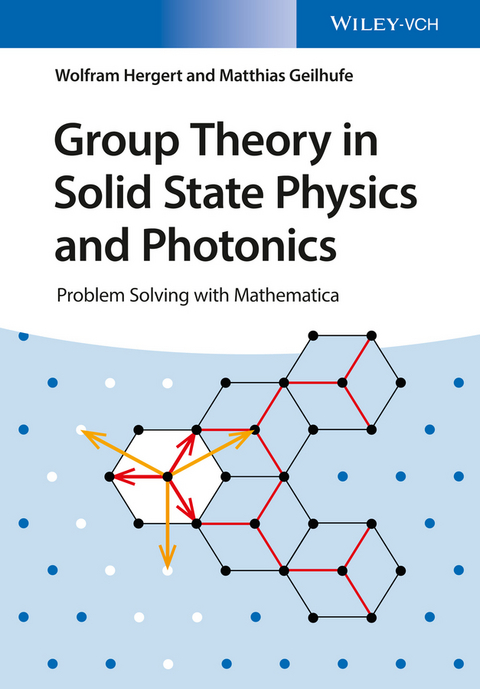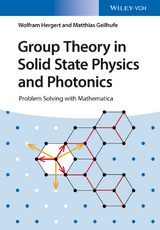Group Theory in Solid State Physics and Photonics
Wiley-VCH (Verlag)
978-3-527-41133-7 (ISBN)
While group theory and its application to solid state physics is well established, this textbook raises two completely new aspects.
First, it provides a better understanding by focusing on problem solving and making extensive use of Mathematica tools to visualize the concepts.
Second, it offers a new tool for the photonics community by transferring the concepts of group theory and its application to photonic crystals.
Clearly divided into three parts, the first provides the basics of group theory. Even at this stage, the authors go beyond the widely used standard examples to show the broad field of applications. Part II is devoted to applications in condensed matter physics, i.e. the electronic structure of materials. Combining the application of the computer algebra system Mathematica with pen and paper derivations leads to a better and faster understanding. The exhaustive discussion shows that the basics of group theory can also be applied to a totally different field, as seen in Part III.
Here, photonic applications are discussed in parallel to the electronic case, with the focus on photonic crystals in two and three dimensions, as well as being partially expanded to other problems in the field of photonics.
The authors have developed Mathematica package GTPack which is available for download from the book's homepage. Analytic considerations, numerical calculations and visualization are carried out using the same software. While the use of the Mathematica tools are demonstrated on elementary examples, they can equally be applied to more complicated tasks resulting from the reader's own research.
Wolfram Hergert, extraordinary professor in Computational Physics, is member of the Theoretical Physics group at University Halle-Wittenberg, Germany. Main subjects of his work are solid state theory, electronic and magnetic structure of nanostructures and photonics. Prof. Hergert has experience in teaching group theory and in applying Mathematica to physical problems. He has published in renowned journals, like Nature and Physical Review Letters, and edited a books on Computational Materials Science and Mie Theory. He is also coauthor of a book on Quantum Theory.
R. Matthias Geilhufe is currently a post-doctoral researcher at the Nordic Institute for Theoretical Physics (Nordita) in Stockholm (Sweden). He completed his undergraduate and postgraduate studies at the Martin Luther University Halle-Wittenberg (Germany) with specialization in theoretical and computational physics and did his PhD in connection with the Max Planck Institute of Microstructure Physics in Halle. His main research interests are in condensed matter theory, in particular functional organic materials, Dirac materials, superconductivity, and topological band theory.
1 Preface
2 Introduction
I Basics of group theory
3 Symmetry operations and transformations of fields
4 Basic abstract group theory
5 Discrete symmetry groups for solid state physics and photonics
6 Representation theory
7 Symmetry in k-space
II Applications in electronic structure theory
8 Solution of the Schroedinger equation
9 Generalization to include the spin
10 Electronic energy bands
III Applications in photonics
11 Solution of Maxwell's equations
12 Twodimensional photonic crystals
13 Threedimensional photonic crystals
14 Other Applications
A Mathematica Package Reference
B Connection of the group theory package to MPB and MEEP
| Erscheint lt. Verlag | 20.6.2018 |
|---|---|
| Verlagsort | Berlin |
| Sprache | englisch |
| Maße | 170 x 244 mm |
| Gewicht | 712 g |
| Einbandart | kartoniert |
| Themenwelt | Mathematik / Informatik ► Mathematik ► Algebra |
| Naturwissenschaften ► Chemie | |
| Naturwissenschaften ► Physik / Astronomie ► Atom- / Kern- / Molekularphysik | |
| Naturwissenschaften ► Physik / Astronomie ► Festkörperphysik | |
| Naturwissenschaften ► Physik / Astronomie ► Optik | |
| Technik ► Elektrotechnik / Energietechnik | |
| Schlagworte | Chemie • Chemistry • Electrical & Electronics Engineering • Electrical & Electronics Engineering • Elektrotechnik u. Elektronik • Festkörperchemie • Festkörperphysik • Festkörperchemie • Festkörperphysik • Gruppentheorie • Materials Science • Materialwissenschaften • Numerical Methods & Algorithms • Numerical Methods & Algorithms • Numerische Methoden u. Algorithmen • Optical and Non-Linear Optical Materials • Optics & Photonics • Optics & Photonics • Optik u. Photonik • Optische u. Nichtlineare Optische Materialien • Photonics & Lasers • Photonics & Lasers • Photonik • Photonik u. Laser • Physics • Physik • solid state chemistry • Solid state physics |
| ISBN-10 | 3-527-41133-X / 352741133X |
| ISBN-13 | 978-3-527-41133-7 / 9783527411337 |
| Zustand | Neuware |
| Informationen gemäß Produktsicherheitsverordnung (GPSR) | |
| Haben Sie eine Frage zum Produkt? |
aus dem Bereich




